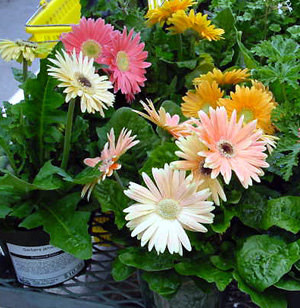Immerse yourself in the radiance of Gerbera Daisies; their vivacious nature shines through every petal. Known for their lively beauty, Gerbera Daisies stand as a symbol of joy and cheer, making them the perfect choice for brightening any celebration.
Timeless Cheer
Gerbera Daisies, with their vibrant hues and captivating blooms, bring a sense of joy to any occasion. Their timeless appeal makes them a versatile expression of emotions—from congratulations to well-wishes.
Offering a kaleidoscope of colors and lively forms, Gerbera Daisies provide versatility that complements any floral arrangement. Whether adorning a centerpiece or gracing a bouquet, these blooms effortlessly elevate the mood, establishing themselves as a favorite among flower enthusiasts.
Calyx Flowers: Crafting Joyful Moments
Step into a world where artisanal craftsmanship meets botanical brilliance. Calyx Flowers is dedicated to infusing enduring joy into every arrangement, making your celebrations even more memorable. Our Gerbera Daisies are carefully selected for their radiance, ensuring that each bloom contributes to the creating moments that last a lifetime.
Indulge in the Calyx difference as we craft joyful moments for you and your loved ones. Visit our floral haven at Calyx Flowers and let the exuberance of Gerbera Daisies transform your special occasions into extraordinary memories.
FAQ About Gerbera Daisies
Q: How do you care for Gerbera Daisies?
A: Place them in bright, indirect sunlight. Keep their soil consistently moist, allowing it to dry slightly between waterings to prevent overhydration. Choose well-draining soil for optimal growth. Maintain a comfortable temperature range between 65°F to 75°F. Nourish your daisies with a balanced fertilizer during the growing season.
Q: What is the significance of Gerbera Daisies in floral arrangements?
A: Gerbera Daisies symbolize joy and positivity, making them a perfect choice for expressing congratulations, gratitude, and well-wishes in floral arrangements. Their vibrant presence adds a burst of energy to weddings, birthdays, and other special occasions.
Q: How long do Gerbera Daisies last in a bouquet?
A: With attentive attention, Gerbera Daisies can illuminate your bouquet, bringing joy for one to two weeks. Consistent water changes and the occasional trim of their stems work wonders in prolonging their freshness, giving you the opportunity to immerse yourself in the enduring vibrancy of these blossoms for an extended duration.

